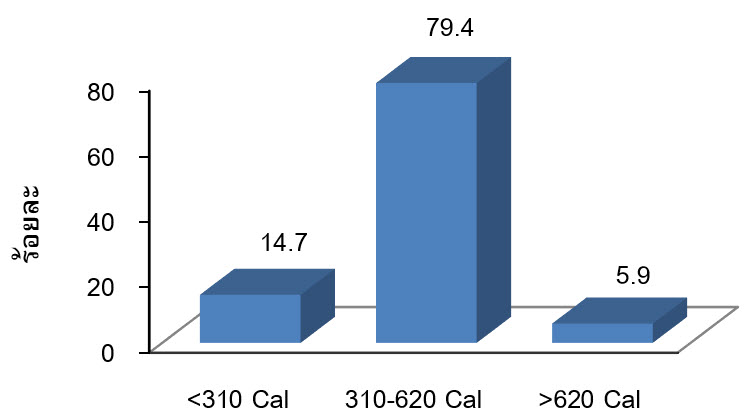การสำรวจสถานการณ์ และทัศนคติของผู้ที่มีบทบาทสำคัญในการขับเคลื่อนโปรแกรมส่งเสริมโภชนาการของโรงเรียน ในจังหวัดสงขลา
Main Article Content
Abstract
Laksana Chaimongkol and Siwaporn Pinkaew
รับบทความ: 2 มิถุนายน 2559; ยอมรับตีพิมพ์: 31 มีนาคม 2560
บทคัดย่อ
การศึกษาครั้งนี้มีวัตถุประสงค์เพื่อศึกษาสถานการณ์ การรับรู้ และทัศนคติของผู้ที่มีบทบาทสำคัญในการขับเคลื่อนโปรแกรมการส่งเสริมโภชนาการของโรงเรียนในจังหวัดสงขลา โดยได้สุ่มตัวอย่างโรงเรียนจำนวน 95 โรง ด้วยวิธี multi-stage cluster sampling ครอบคลุมโรงเรียนประถม ศึกษาขนาดเล็ก กลาง และใหญ่ในสังกัดสำนักงานคณะกรรมการการศึกษาขั้นพื้นฐาน องค์การบริหารส่วนท้องถิ่น และสำนักงานคณะกรรมการส่งเสริมการศึกษาเอกชน เก็บข้อมูลด้วยการสังเกตและการสัมภาษณ์อย่างมีโครงสร้าง ผลการศึกษาพบว่า ทุกโรงเรียนมีบริการอาหารกลางวัน ร้อยละ 78 ของโรงเรียนปรุงประกอบอาหารโดยแม่ครัวภายใต้การควบคุมของโรงเรียน ปริมาณพลังงานเฉลี่ยต่อ 1 สำรับเท่ากับ 418.1 ± 117.3 กิโลแคลอรี ร้อยละ 79.4 ของสำรับที่จัดเป็นอาหารกลางวันมีพลังงานอยู่ในช่วงร้อยละ 20 – 40ThaiDRI มีวิตามินเอ ธาตุเหล็ก และแคลเซียมต่ำกว่าค่ามาตรฐาน โรงเรียนส่วนใหญ่มีการบูรณาการความรู้ทางโภชนาการในรายวิชาการงานอาชีพและสุขศึกษาเป็นหลัก มีเพียง 9 โรงเท่านั้นที่มีการบูรณาการในรายวิชาอื่น ๆ โรงเรียนร้อยละ 96.6 มีการจัดกิจกรรมเสริมหลักสูตรที่ส่งเสริมโภชนาการโดยมีการจัดกิจกรรมที่หลากหลายตั้งแต่ 1 – 5 กิจกรรม ผู้บริหารสถานศึกษา ผู้ดำเนินกิจกรรมส่งเสริมโภชนาการ เช่น ครู แม่ครัว รวมทั้งผู้สนับสนุน เช่น ผู้ปกครอง อบต. และชุมชน มีทัศนคติที่ดีต่อการส่งเสริมโภชนาการในโรงเรียน ในขณะที่มีการประเมินคุณภาพการบริหารงานส่งเสริมโภชนาการในโรงเรียนอยู่ในระดับปานกลาง ร้อยละ 70 – 75 ของผู้บริหารสถานศึกษาและผู้ดำเนินงาน ระบุว่า มีอุปสรรคในการพัฒนาโรงเรียนเข้าสู่มาตรฐานของโปรแกรมส่งเสริมโภชนาการในโรงเรียน และต้องการการสนับสนุนจากหน่วยงานภายนอกใน 3 เรื่องหลัก คือ การพัฒนาบุคลากรที่เกี่ยวข้อง การให้คำปรึกษาและพี่เลี้ยงในระหว่างการพัฒนาโรงเรียน รวมทั้งงบประมาณ
คำสำคัญ: โภชนาการในโรงเรียน โครงการอาหารกลางวัน โปรแกรมการส่งเสริมโภชนาการ
Abstract
This study aimed to reveal how the school-based nutrition promotion program (SNPP) have been practiced in Songkhla including exploring the perception and attitude of key persons who operated SNPP. Ninety-five schools were randomly selected from all types and sizes of schools by multi-stage cluster sampling method. Data collection was done by observation and structured interview. It was found that the school lunch program have been run in all schools. About 78% of those have lunch cooked by lay person under their supervision. The average energy content was 418.1±117.3 kilocalories per one meal set. Most (79.4%) meal sets had energy ranged from 20 to 40%ThaiDRI. Vitamin A, iron and calcium contents were lower than recommendation. Almost schools integrated nutrition education in the class which was only in 2 subjects, i.e., home working and technology as well as physical education. There were only 9 schools where integrated nutrition education in more various subjects. About 96.6% of schools run nutrition related co-curriculums which ranged from 1 to 5 activities. The administrators, operation staffs (e.g., teachers, cooks) and supporters (e.g., parents, local authorities, and communities) had good attitude in SNPP while they recognized the quality of SNPP in their schools as fair level. To reach the standard of SNPP, about 70 – 75% of administrators and operation staffs indicated that there were some barriers in developing the existing SNPP. They also needed supports in capacity building of the related staffs, consultants or mentors as well as budget in developing their schools up to standard SNPP.
Keywords: Nutrition in school, School lunch program, Nutrition promotion program
Downloads
Article Details

This work is licensed under a Creative Commons Attribution-NonCommercial 4.0 International License.
References
Bureau of Nutrition. (2005). 5th National Food and Nutrition Survey. Nonthaburi: Ministry of Health. (in Thai)
Cho, H. and Nadow, Z. (2004). Understanding barriers to implementing quality lunch and nutrition education. Journal of Community Health 29(5): 421–435.
Department of Health. (2015). Manual of School Health Promotion B.E. 2558. Nonthaburi: Ministry of Health. (in Thai)
Food and Nutrition Policy for Health Promotion. (2014). Research Report of the Survey on Food Environment in School & around School and Study of Food Consumption Behavior of School Children and Related Factors, Phase I (B.E. 2556–2557). Retrieve from http://www.fhpprogram.org/media/pdfs/reports/731cf5a3df094a7ed786bdb5d19c83df.pdf, November 4, 2016. (in Thai)
Jones, A. M., and Zidenberg-Cherr, S. (2015). Exploring nutrition education resources and barriers, and nutrition knowledge in teachers in California. Journal of Education and Behavior 47: 162–169.
Mo-Suwan, L. (2012). Nutrition Story: Enhancing Full Potential Growth of Thai Children under the Project of System and Mechanism development for Optimal Nutrition in Thai Children. Songkhla: Prince of Songkla University. (in Thai)
Nakamura, T. (2008). The integration of school nutrition promotion program into health promotion and prevention of lifestyle-related diseases in Japan. Asia Pacific Journal of Clinical Nutrition 17(suppl. 1): 349–351.
Office of Vocational Education Commission. (2011). Manual for Sustainable School Lunch Program Operation. Bangkok: Ministry of Education. (in Thai)
Peemanee, K., Thaiboonrod, A., Chitchang, U. and Banjong, O. (2010). Manual of INMU-SchoolLunch Program. Nokhon Pathom: Institute of Nutrition, Mahidol University. (in Thai)
Phulkerd, S., Phonguttha, S and Phonsuk, P. (2014). 2nd Annual Report of Food and Nutrition Plan for Health Promotion. Nonthaburi: Food and Nutrition Plan for Health Promotion. (in Thai)
Proactive Nutrition Initiative Program Center. (2010a). Manual for Evaluation of Excellent Nutrition Promotion in School. Bangkok: Thai Health Promotion Foundation. (in Thai)
Proactive Nutrition Initiative Program Center. (2010b). Manual for Food Management in School. Nonthaburi: Ministry of Health. (in Thai)
Sherman, J. and Muehlhoff, E. (2007). Developing a nutrition and health education program for primary schools in Zambia. Journal of Education and Behavior, 39: 335–342.
Tanaka, N. and Miyoshi, M. (2012). School lunch program for health promoting among children in Japan. Asia Pacific Journal of Clinical Nutrition 21(1):155–158.
Wang, D. and Stewart, D. (2013). The implementation and effectiveness of school-based nutrition promotion programmes using a health-promoting schools approach: A systemic review. Public Health Nutrition 16(6): 1082–1100.
Watts, S. O., Pinero, D. J. and Alter, M. M. (2012). An assessment of nutrition education in selected counties in New York State Elementary School (Kindergarten through fifth grade). Journal of Education and Behavior 44: 474–480.
World Health Organization. (1998). Health-Promoting Schools: A Healthy setting for Living, Learning, and working. Geneva: World Health Organization.
